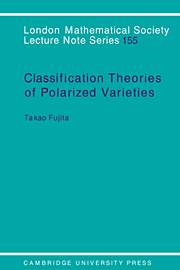Introduction
Published online by Cambridge University Press: 17 March 2010
Summary
By a polarized variety we mean a pair (V, L) consisting of a projective variety V and an ample line bundle L on it. We will classify such pairs and describe their structure as precisely as possible.
Needless to say, algebraic varieties are the main object in algebraic geometry. In this book, however, we mainly consider the pair (V, L) rather than the variety V itself. There are several reasons of taking this viewpoint.
First of all, polarization (or the linear system defined by it) is very important for describing the structure of a variety. For example, the projective space ℙn is described by a homogeneous coordinate system, namely a linear parametrization of H0(ℙn, O(1)). But it is by no means easy to recognize a projective space without being given a polarization. For beginners it takes some thought to see that a twisted cubic in ℙ3 is isomorphic to ℙ1, and this is because the polarization O(1) is not given a priori. Another example is the space parametrizing linear ℙ2's contained in a smooth hyperquadric in ℙ5. This is actually isomorphic to ℙ3. Is that obvious to you?
There are polarizations which are not very ample but are useful for this purpose. For example, let f: V → ℙn be a finite double covering. Then L = f*O(1) is ample, but not very ample.
- Type
- Chapter
- Information
- Classification Theory of Polarized Varieties , pp. vii - xivPublisher: Cambridge University PressPrint publication year: 1990

